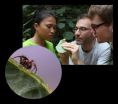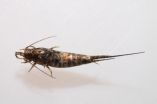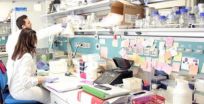(Press-News.org) This news release is available in German.
Predictive maintenance of hard-to-access plants, no unnecessary oil changes, no unnecessary laboratory costs and less environmental impact. These are just some of the benefits offered by a new system that can monitor the condition of lubricating oils, hydraulic oils and other fluids in industrial installations without interrupting ongoing operations. The method was developed by engineers from Saarbrücken in collaboration with project partners. The compact sensor system is available as a portable unit or can be built into industrial plants, wind turbines and other machinery. The system, which uses optical methods to measure the oil's chemical makeup and the degree of particle loading, can also predict the best time for an oil change. The team of engineers led by Professor Andreas Schütze from Saarland University and ZeMA, the Centre for Mechatronics and Automation Technology in Saarbrücken, will be showcasing their work from April 7th to April 11th at the Saarland Research and Innovation Stand at HANNOVER MESSE (Hall 2, Stand C 48).
Failing to change the oil at the right time can cause serious damage to machinery and equipment. A fact that is just as true for cars as it is for large industrial installations. Over time, a lubricating oil used to minimize friction, reduce wear and prevent overheating will become contaminated with fine metal dust and particles from abrasive processes. The oil will also gradually oxidize. And the additives that help to optimize the oil's properties also have only a finite lifetime. At some point, the oil will no longer be able to act as an effective lubricant. According to Professor Andreas Schütze, the key problem is that it is not obvious when exactly the oil needs changing. In the case of plants or installations that are difficult to reach – such as offshore wind turbines – the method adopted up to now has been either to take oil samples and have them examined in costly laboratory analyses or to simply change the oil at some regular interval. "As a result, a great deal of effort is expended in changing oil that is still actually useable, which is costly for both the operator and the environment," explains Professor Schütze.
In collaboration with partners from other universities and industry, Schütze's team at the Lab for Measurement Technology and at ZeMA have developed a measurement system that can be integrated directly into industrial installations where it continuously measures and monitors oil ageing and degradation while the installation continues to operate. The data from the measurement system are currently transmitted by mobile radio communication so that analysis and assessment can be performed off-site. A portable version of the system also exists. At HANNOVER MESSE, the engineers will be exhibiting a small case that contains all the equipment needed (from the measuring cell to the display unit) for on-site testing of the oil's quality. "Our system allows us to identify and avert potential damage early on. We can predict when maintenance work will be needed and plant operators can plan accordingly," explains Schütze. The method is also suitable for use with hydraulic systems. And the measurement system can test not only oils, but can also be used to monitor the condition of other fluids.
The methods developed by the engineers in Saarbrücken involve shining light into the liquid being monitored. In one case, light from a laser diode is scattered by any particles present in the oil or fluid. "Each different type of particle scatters the light in a particular way, causing more or less light to be measured in the various spatial directions. The scattered light is then recorded by photodiodes and the signals analysed. The system allows us to distinguish between metal dust, other solid particles and air bubbles and to determine the concentration of each," explains engineer Eliseo Pignanelli, who has been involved in refining the system. The second optical technique measures the absorption of infrared light by the fluid at specific wavelengths as it flows through the measurement system. "This permits us to draw conclusions about the chemical state of the oil, because chemical changes to the oil will cause changes in the light spectrum that we record," says Pignanelli. This spectroscopic analysis also enables the presence of water in the oil to be detected.
The team of engineers at Saarbrücken have been developing the system in a number of research projects, including the "FluidSens" and "NaMiFlu" projects that are collaborative efforts involving partners from academic institutions and from industry. Industrial partners include HYDAC Electronic GmbH in Gersweiler and EADS Deutschland GmbH (Innovation Works). One of the main areas of research concerned optimizing the optical and mechanical properties of the nanostructured layers used in the microsensors and adapting them for use at high pressures. Working with ZeMA in Saarbrücken, the technology is now being developed into a market-ready product.
INFORMATION:
The research work has been funded by the Federal Ministry of Education and Research, the Saarland Ministry of Economics and Science and the European Regional Development Fund.
A press photograph is available at http://www.uni-saarland.de/pressefotos and can be used at no charge.
Contact:
Prof. Dr. Andreas Schütze, Tel.: +49 (0)681 302-4663, E-mail: schuetze@lmt.uni-saarland.de
Dipl.-Ing. Eliseo Pignanelli: Tel.: +49 (0)681 85 787 44, E-mail: e.pignanelli@lmt.uni-saarland.de
http://www.lmt.uni-saarland.de
From April 7-11, the Saarland Research and Innovation Stand (Hall 2, Stand C 48) at HANNOVER MESSE can be reached by calling +49 (0)681 302-68500 or +49 (0)162 2137298.
Note for radio journalists: Studio-quality telephone interviews can be conducted using broadcast audio IP codec technology (IP direct dial or via the ARD node 106813020001). Interview requests should be addressed to the university's Press and Public Relations Office (+49 (0)681 302-64091 or -2601).
Background:
The Saarland Research and Innovation stand at HANNOVER MESSE is organized by Saarland University's Contact Centre for Technology Transfer (KWT). KWT is the central point of contact for companies interested in exploring opportunities for cooperation and collaboration with researchers at Saarland University. Saarland University is a member of the "EXIST" programme initiated by the Federal Ministry of Economics and Energy. The programme aims to improve the entrepreneurial environment at universities and research institutions and increase the number of technology- and knowledge-based business start-ups. http://www.uni-saarland.de/kwt
Saarland University, Saarland University of Applied Sciences (HTW) and industrial partners are working together at ZeMA in Saarbrücken to strengthen the fields of mechatrocnic engineering and industrial automation in Saarland and to promote technology transfer. ZeMA is home to a large number of industry-specific development projects and projects aiming to transform research findings into practical industrial applications.
http://www.zema.de/
Predicting oil changes in industrial applications without interrupting operations
Hannover Messe
2014-03-27
ELSE PRESS RELEASES FROM THIS DATE:
Democratizing data visualization
2014-03-27
In 2007, members of the Haystack Group in MIT's Computer Science and Artificial Intelligence Laboratory released a set of Web development tools called "Exhibit." Exhibit lets novices quickly put together interactive data visualizations, such as maps with sortable data embedded in them; sortable tables that automatically pull in updated data from other sites; and sortable displays of linked thumbnail images.
In April, at the Association for Computing Machinery's Conference on Human Factors in Computing Systems, Haystack members will present an in-depth study of the ways ...
Students on field course bag new spider species
2014-03-27
As a spin-off (pun intended) of their Tropical Biodiversity course in Malaysian Borneo, a team of biology students discover a new spider species, build a makeshift taxonomy lab, write a joint publication and send it off to a major taxonomic journal.
Discovering a new spider species was not what she had anticipated when she signed up for her field course in Tropical Biodiversity, says Elisa Panjang, a Malaysian master's student from Universiti Malaysia Sabah. She is one of twenty students following the course, organised by Naturalis Biodiversity Center in The Netherlands, ...
The first insects were not yet able to smell well
2014-03-27
This news release is available in German. An insect's sense of smell is vital to its survival. Only if it can trace even tiny amounts of odor molecules is it is able to find food sources, communicate with conspecifics, or avoid enemies. According to scientists at the Max Planck Institute for Chemical Ecology in Jena, Germany, many proteins involved in the highly sensitive odor perception of insects emerged rather late in the evolutionary process. The very complex olfactory system of modern insects is therefore not an adaptation to a terrestrial environment when ancient ...
One gene, many tissues
2014-03-27
Genes are the "code" for building the biological elements that form an organism. The DNA that makes up genes contains the instructions to synthesise proteins, but it's wrong to think that, for a given gene, these instructions are always the same for all parts of the organisms. In actual fact, the gene varies depending on the tissue where it is located (cerebral cortex, cerebellum, olfactory epithelium, etc.); in particular, what varies is the point in the "string" of code at which protein synthesis starts. This complexity complicates the work of scientists considerably, ...
How size splits cells
2014-03-27
One of the scientists who revealed how plants "do maths" can now reveal how cells take measurements of size. Size is important to cells as it determines when they divide.
In a paper published in eLife, Professor Martin Howard from the John Innes Centre and colleagues from the US, Germany and Singapore discovered that cells measure their surface area using a particular protein, cdr2p. The finding challenges a previous model suggesting that another protein called pom1p senses a cell's length.
"Many cell types have been shown to reach a size threshold before they commit ...
Natural plant compounds may assist chemotherapy
2014-03-27
Auckland, New Zealand. 27 March 2014...Researchers at Plant & Food Research have identified plant compounds present in carrots and parsley that may one day support more effective delivery of chemotherapy treatments.
Scientists at Plant & Food Research, working together with researchers at The University of Auckland and the National Cancer Institute of The Netherlands, have discovered specific plant compounds able to inhibit transport mechanisms in the body that select what compounds are absorbed into the body,and eventually into cells. These same transport mechanisms ...
Smoke-free air policies seem to protect the heart
2014-03-27
WASHINGTON (March 27, 2014) — A new study on the impact of Michigan's statewide smoking ban adds to mounting evidence that policies prohibiting tobacco smoking in workplaces and other public spaces may substantially improve public health by reducing heart disease and death, according to research to be presented at the American College of Cardiology's 63rd Annual Scientific Session.
Studies on previous indoor smoking bans have consistently shown a major decrease in hospital admissions for heart attacks after smoke-free laws went into effect. Secondhand smoke exposure is ...
The heart responds differently to exercise in men vs. women
2014-03-27
WASHINGTON (March 27, 2014) — The formula for peak exercise heart rate that doctors have used for decades in tests to diagnose heart conditions may be flawed because it does not account for differences between men and women, according to research to be presented at the American College of Cardiology's 63rd Annual Scientific Session.
The simple formula of "220 minus age" has been widely used to calculate the maximum number of heart beats per minute a person can achieve. Many people use it to derive their target heart rate during a workout. Doctors use it to determine how ...
Cholesterol levels vary by season, get worse in colder months
2014-03-27
WASHINGTON (March 27, 2014) — Cholesterol levels fluctuate based on the time of year with more unfavorable lipid profiles seen in the colder months, a trend that may be driven by related behavior changes, according to research to be presented at the American College of Cardiology's 63rd Annual Scientific Session.
While previous studies have shown that heart attacks and heart-related deaths increase during the winter months, researchers at Johns Hopkins Ciccarone Center for the Prevention of Heart Disease were interested in finding out whether cholesterol parameters might ...
Mediterranean diet may lower risk of diabetes
2014-03-27
WASHINGTON (March 27, 2014) — Adoption of a Mediterranean diet is linked to a lower risk of diabetes, especially among people at high risk for cardiovascular disease, according to research to be presented at the American College of Cardiology's 63rd Annual Scientific Session.
Data from the first pooled analysis of studies evaluating the possible role of the Mediterranean diet on diabetes development show that adherence to this diet was associated with a 21 percent reduced risk of diabetes as compared to the control dietary groups. This reduced risk was even more pronounced ...
LAST 30 PRESS RELEASES:
NTIDE: Disability employment holds steady after data hiatus
Social lives of viruses affect antiviral resistance
Dose of psilocybin, dash of rabies point to treatment for depression
Helping health care providers navigate social, political, and legal barriers to patient care
Barrow Neurological Institute, University of Calgary study urges “major change” to migraine treatment in Emergency Departments
Using smartphones to improve disaster search and rescue
Robust new photocatalyst paves the way for cleaner hydrogen peroxide production and greener chemical manufacturing
Ultrafast material captures toxic PFAS at record speed and capacity
Plant phenolic acids supercharge old antibiotics against multidrug resistant E. coli
UNC-Chapel Hill study shows AI can dramatically speed up digitizing natural history collections
OYE Therapeutics closes $5M convertible note round, advancing toward clinical development
Membrane ‘neighborhood’ helps transporter protein regulate cell signaling
Naval aviator turned NPS doctoral student earns national recognition for applied quantum research
Astronomers watch stars explode in real time through new images
Carbon-negative building material developed at Worcester Polytechnic Institute published in matter
Free radicals caught in the act with slow spectroscopy
New research highlights Syntax Bio’s platform for simple yet powerful programming of human stem cells
Researchers from the HSE University investigated reading in adolescents
Penn Nursing study: Virtual nursing programs in hospitals fall short of expectations
Although public overwhelmingly supports hepatitis B vaccine for a newborn, partisan differences exist
DFW backs UTA research to bolster flood resilience
AI brain scan model identifies stroke, brain tumors and aneurysms – helping radiologists triage and speed up diagnoses
U.S. News & World Report gives Hebrew Rehabilitation Center highest rating
Optica and DPG name Antoine Browaeys 2026 Herbert Walther Award recipient
The presence of a gun in the home increases the risk of suicide by three to five times
PFAS exposure and endocrine disruption among women
Vaccines and the 2024 US presidential election
New approach narrows uncertainty in future warming and remaining carbon budget for 2 °C
When pregnancy emergencies collide with state abortion bans
American College of Cardiology supports front of package nutrition labeling
[Press-News.org] Predicting oil changes in industrial applications without interrupting operationsHannover Messe



